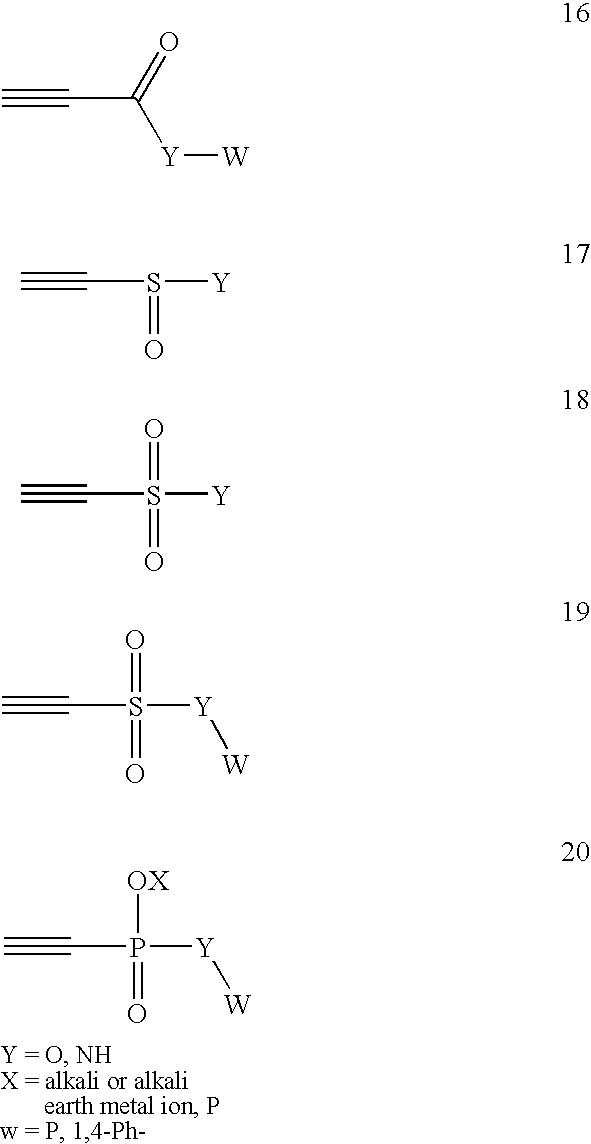Conjugate addition reactions for the controlled delivery of pharmaceutically active compounds
a technology of conjugate addition and controlled delivery, which is applied in the direction of enzymology, prosthesis, drug composition, etc., can solve the problems of limited clinical usefulness and low yield of pharmaceutically active compounds delivered from biomaterials, and achieve the effect of reducing or delaying the onset of symptoms
- Summary
- Abstract
- Description
- Claims
- Application Information
AI Technical Summary
Benefits of technology
Problems solved by technology
Method used
Image
Examples
example 1
Preparation of Basic Reagents
Acrylation of Poly(ethylene glycol)diol
[0242]Polyethylene glycol, mol. wt. 8000 (50 g, 6.25 mmol, 12.5 mmol hydroxyl groups, Aldrich, Milwaukee, Wis., USA) was added to toluene (500 ml) and dried by azeotropic distillation. The mixture was cooled to 0° C. and 100 ml of anhydrous dichloromethane (Aldrich) was added. Triethylamine (2.61 ml, 8.75 mmol, 1.5 eq. based on hydroxy groups, Aldrich) was added, followed by dropwise addition of acryloyl chloride (2.03 ml, 18.75 mmol, 1.5 eq., Aldrich). The reaction was kept under Ar overnight in the dark. The product was filtered and then recovered by precipitation in hexane with stirring. The product was redissolved in 75 ml of dichloromethane and precipitated again in hexane with stirring. The product was dried overnight under vacuum. The product was dissolved in 500 ml of water with 25 g NaCl, and the pH was adjusted to pH 6. The solution was extracted with dichloromethane (Aldrich) 3 times (the first extraction...
example 2
Gel Formation by Conjugate Addition Reactions
Gels Formed by Conjugate Addition with a Low Molecular Weight tri-thiol and a PEG-linked Unsaturation: Trimethylolpropane tris(3-mercaptopropionate) and PEG Diacrylate
[0262]50 mg PEG-8000-2A was dissolved at 0.1 g / ml in 500 microliters of 4:1 50 mM bicarbonate buffer (pH 8.4): acetonitrile. 1.1 microliters of trimethylolpropane tris(3-mercaptopropionate) (1.25 equivalents based on acrylates)were added and the solution mixed by vortexing. The trimethylolpropane tris(3-mercaptopropionate) was not perfectly miscible in the solution but formed a suspension of small droplets in the aqueous phase. The material did not gel in two hours but was let to sit overnight. At approximately 12 hours after addition of the trimethylolpropane tris(3-mercaptopropionate), a solid cross-linked material had formed. Water was added to the material, which swelled with the water but did not dissolve (time scale: weeks before gel finally discarded due to contaminat...
example 3
General Protocols for Immobilizing Peptides and Testing Activity with Cells in Culture
Peptide Immobilization in Gels in which the Peptide is Immobilized by Conjugate Addition and the Gel is Formed by Conjugate Addition
[0273]13.9 mg PEG-2500-3A was dissolved in 69.5 microliters (5.0 mg / 25 microliters) of PBS●TEA (1.0 mM PBS containing 13 microliters of triethanolamine / ml) containing GCGYGRGDSPG (SEQ ID NO: 61) at a concentration of 3.2 mg GCGYGRGDSPG (SEQ ID NO: 61) / ml. 7.0 mg GCYKNRDCG (SEQ ID NO: 58) was dissolved in 65 microliters of PBS●TEA (2.7 mg / 25 microliter). The GCYKNRDCG (SEQ ID NO: 58) was filtered through a 0.22 micron filter. After 9 minutes of reaction time, the PEG-25000-3A / GCGYGRGDSPG (SEQ ID NO: 61) solution was separately filtered through a 0.22 micron filter. As soon as the filtrations were complete, equivolumes (25 microliters) of the two solutions were added to wells of a Corning flat-bottomed tissue culture treated polystyrene 96 well plates. As the second of t...
PUM
| Property | Measurement | Unit |
|---|---|---|
| Temperature | aaaaa | aaaaa |
| Temperature | aaaaa | aaaaa |
| Temperature | aaaaa | aaaaa |
Abstract
Description
Claims
Application Information
 Login to View More
Login to View More - R&D
- Intellectual Property
- Life Sciences
- Materials
- Tech Scout
- Unparalleled Data Quality
- Higher Quality Content
- 60% Fewer Hallucinations
Browse by: Latest US Patents, China's latest patents, Technical Efficacy Thesaurus, Application Domain, Technology Topic, Popular Technical Reports.
© 2025 PatSnap. All rights reserved.Legal|Privacy policy|Modern Slavery Act Transparency Statement|Sitemap|About US| Contact US: help@patsnap.com



